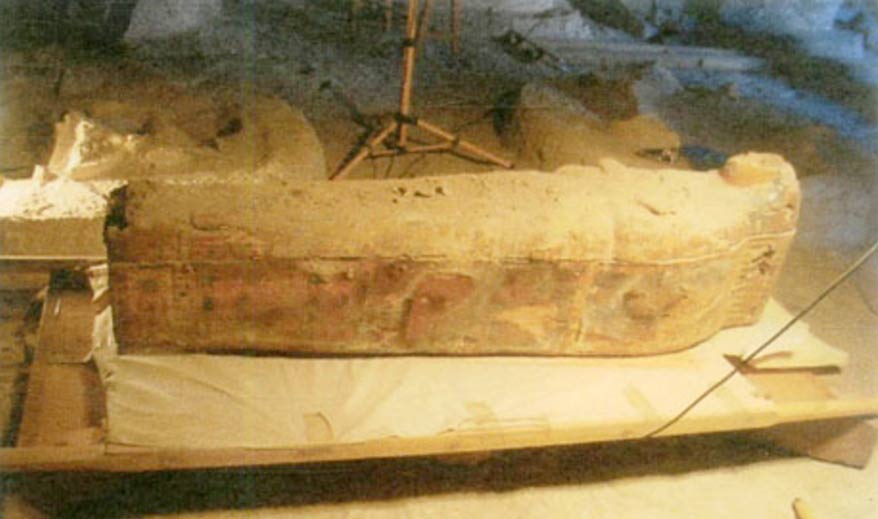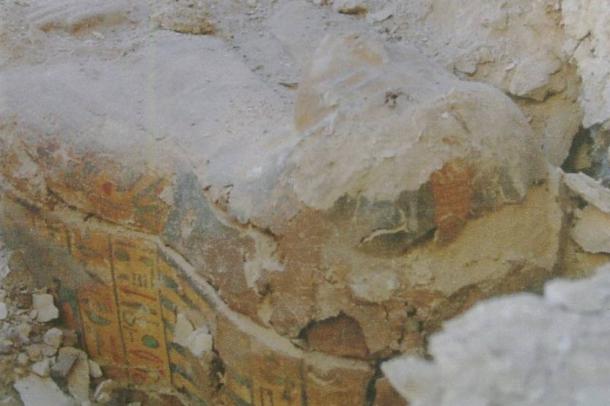It looks like you're using an Ad Blocker.
Please white-list or disable AboveTopSecret.com in your ad-blocking tool.
Thank you.
Some features of ATS will be disabled while you continue to use an ad-blocker.
14
share:
Spanish archaeologists unearthed an intact sarcophagus during restoration work at the tomb of Amenhotep Huy (tomb TT40) in the Qurnet Murai
Necropolis, part of the greater Theban Necropolis on the west bank of the Nile river containing the tombs of several New Kingdom officials.
Amenhotep Huy was Viceroy of Kush under Tutankhamen ("King Tut"). He was the successor of Tuthmosis who served under Tutankhamen's father, Akhenaten and the predecessor of his own son and grandson, Paser I and Amenemopet, who served under the next four pharaohs (Ay, Horemheb, Ramesses I, Seti I).
From Ancient Origins (via Obscuragator):
 The sarcophagus. Image Credit: Ahram Online
The sarcophagus. Image Credit: Ahram Online
 Another view of the sarcophagus. Image Credit: Ahram
Online
Another view of the sarcophagus. Image Credit: Ahram
Online
In the Egyptian Pantheon, Amun (aka Amon) was a self-created wind deity who was merged with the Sun god Ra, becoming Amun-Ra (or Amon-Ra), king of the gods, principal deity of the New Kingdom.
The sarcophagus is described as being typical of the style of the 21st Dynasty which would put it several hundred years after the time of Amenhotep Huy and it's not clear from any of the articles I've read if the sarcophagus was located in the tomb and if so, how it came to be there.
Earlier this year, another Amun temple singer, Tjayasetimu, was the subject of an exhibition at the British Museum. The sarcophagus containing the mummy of the young girl — estimated to have been between 7 and 9 — was brought to the museum in 1888 but remained in storage in a vault until the 1970's. Tjayasetimu and her sarcophagus were bought from an antiquities dealer and the location of the tomb in which she was found is unknown.
Amenhotep Huy was Viceroy of Kush under Tutankhamen ("King Tut"). He was the successor of Tuthmosis who served under Tutankhamen's father, Akhenaten and the predecessor of his own son and grandson, Paser I and Amenemopet, who served under the next four pharaohs (Ay, Horemheb, Ramesses I, Seti I).
From Ancient Origins (via Obscuragator):

The coffin is carved from wood and covered with plaster, which is painted with scenes depicting different ancient Egyptian gods, including Thoth, Anubis, Osiris, Isis, and the four sons of Horus. Inside, the mummy is wrapped in linen and the face is covered with a mask. There is also a religious necklace found on the chest and a wig decorated with a flower crown on the head.
Abdel Hakim Karrar antiquities director general in Upper Egypt, told Ahram Online that hieroglyphic text engraved on the sarcophagus identifies the mummy as “Amun’s singer”. This suggests the mummy may be female as it was women that usually held the role of singer within temples, while men played instruments in rituals held outside the temple.

In the Egyptian Pantheon, Amun (aka Amon) was a self-created wind deity who was merged with the Sun god Ra, becoming Amun-Ra (or Amon-Ra), king of the gods, principal deity of the New Kingdom.
The sarcophagus is described as being typical of the style of the 21st Dynasty which would put it several hundred years after the time of Amenhotep Huy and it's not clear from any of the articles I've read if the sarcophagus was located in the tomb and if so, how it came to be there.
Earlier this year, another Amun temple singer, Tjayasetimu, was the subject of an exhibition at the British Museum. The sarcophagus containing the mummy of the young girl — estimated to have been between 7 and 9 — was brought to the museum in 1888 but remained in storage in a vault until the 1970's. Tjayasetimu and her sarcophagus were bought from an antiquities dealer and the location of the tomb in which she was found is unknown.
edit on 2014-12-9 by theantediluvian because: (no reason given)
Very interesting. It is great that these things are found every now and then. I always wonder if any treasure is "officially found" when they find
these things. I am sure that some souvenirs of the dig are taken home by the archeologists and not mentioned. I'll rub your back, you rub mine.
a reply to: rickymouse
Even if that were the case, the alternative is much worse. Until fairly recent times, museum artifacts were largely obtained from unscrupulous dealers who in turned purchased them from looters who destroy not only physical objects but the context of the artifacts (assuming the artifacts they purchased weren't forgeries!).
Even if that were the case, the alternative is much worse. Until fairly recent times, museum artifacts were largely obtained from unscrupulous dealers who in turned purchased them from looters who destroy not only physical objects but the context of the artifacts (assuming the artifacts they purchased weren't forgeries!).
Always amazed when things like this come to light. Archeology is something I would love to get involved in, but It would be a long path.
So much is still buried out in the sands. A huge find I feel is just around the corner, what that is I don't know.
S+F
So much is still buried out in the sands. A huge find I feel is just around the corner, what that is I don't know.
S+F
new topics
-
Denmark's Notre-Dame moment - 17th Century Borsen goes up in Flames
Mainstream News: 39 minutes ago -
We need less laws in the UK not more
General Chit Chat: 3 hours ago -
The Baloney aka BS Detection Kit
Social Issues and Civil Unrest: 8 hours ago -
Suspected Iranian agent working for Pentagon while U.S. coordinated defense of Israel
US Political Madness: 8 hours ago -
How does my computer know
Education and Media: 11 hours ago
top topics
-
Suspected Iranian agent working for Pentagon while U.S. coordinated defense of Israel
US Political Madness: 8 hours ago, 14 flags -
USO 10 miles west of caladesi island, Clearwater beach Florida
Aliens and UFOs: 15 hours ago, 9 flags -
The Baloney aka BS Detection Kit
Social Issues and Civil Unrest: 8 hours ago, 6 flags -
We need less laws in the UK not more
General Chit Chat: 3 hours ago, 4 flags -
How does my computer know
Education and Media: 11 hours ago, 3 flags -
Denmark's Notre-Dame moment - 17th Century Borsen goes up in Flames
Mainstream News: 39 minutes ago, 2 flags
14
